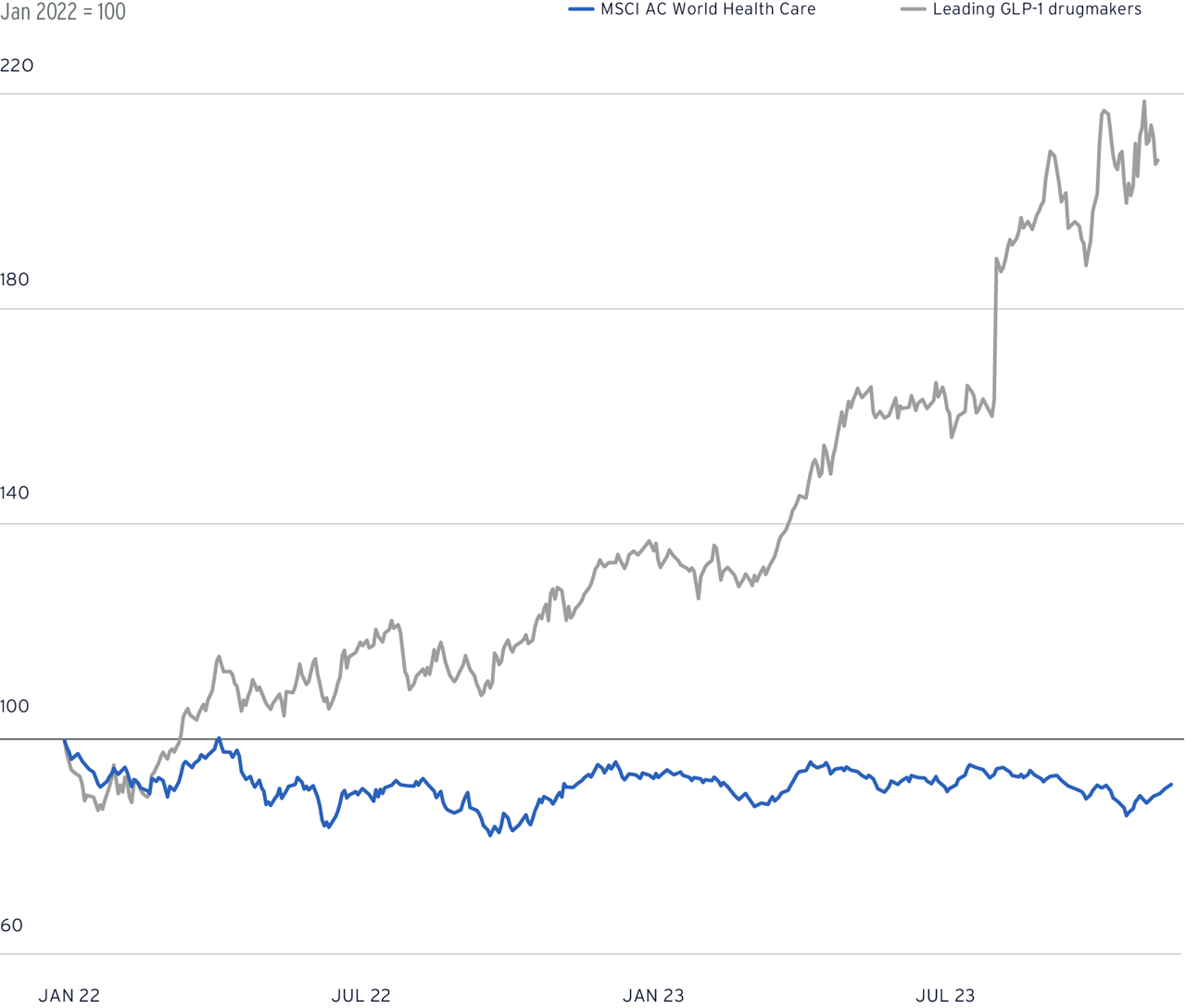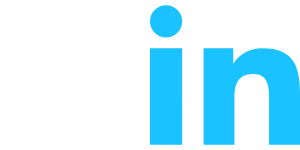
Investing in healthcare 2024
We all share the inevitable journey of aging and more of us are farther along on that journey than ever before. According to American Association of Retired Persons (AARP), in the US alone, 10,000 people turn 65 each day. According to the National Council on Aging, nearly 80% of adults 60 and older have two or more chronic conditions.
Healthcare services consumes an ever-growing share of our household expenditures and is becoming a financial burden on many governments and societies. Reversing that tide requires better health outcomes at a lower cost of care. Within the Healthcare sector, that will necessitate a shift from the traditional approach of managing symptoms to addressing underlying causes, and from treating disease to preventing it.
Innovation is leading these healthcare paradigm shifts. Exciting technological advancements are being developed and deployed across every sub-sector of Healthcare, promising transformative breakthroughs in medicines, procedures, hospital care, nutrition and preventative actions in people’s daily lives.
Since the mapping of the human genome at the turn of this century, various biologics-based platforms have emerged to treat a wide array of medical conditions. Biopharmaceutical companies are leveraging these platforms and successfully advancing drugs through the approval process to finally offer hope for age-related mysteries like Alzheimer’s. We also see less toxic, more targeted and more personalized approaches to treating cancer (still the second-largest killer of people over the age of 65).
Treating obesity is an example of how healthcare can change rapidly. Now, with a new class of weight-loss medications, we see lower rates of diabetes, heart disease and associated co-morbidities among its growing user base.
Of course, innovation takes capital. And higher interest rates have raised the cost of financing research and development (R&D), the foundation of the innovation cycle.
Higher rates and tighter capital spending, along with regulatory uncertainty and an ongoing hangover from COVID-19, weighed on Healthcare share prices in 2023. Even the remarkable success of the weight-loss drugs turned into a kind of headwind, as investors shunned (prematurely, we believe) the stocks of insulin, device and heart medication makers in the belief that demand for these solutions would decline as waistlines slim. To boot, the year marked the first earnings recession for Healthcare shares in decades.
For those dialed into the twin unstoppable trends of longevity and innovation, however, the 2023 downturn has created opportunities. Many of the issues that held back Healthcare stocks are transitory, in our opinion, thus creating a favorable setup for the sector’s potential outperformance in 2024.
FIGURE 1: Share price returns for the pair of manufacturers responsible for the two leading GLP-1 weight loss drugs versus the rest of the developed market Healthcare sector.

Source: Bloomberg as of November 22, 2023. Indices are unmanaged. An investor cannot invest directly in an index. They are shown for illustrative purposes only and do not represent the performance of any specific investment. Index returns do not include any expenses, fees or sales charges, which would lower performance. Past performance is no guarantee of future results. Real results may vary.
A perfect cyclical storm
A key headwind to drug development over the past two years has been higher interest rates. The trend has been especially tough on early-stage biopharma companies that rely on external funding to fuel their R&D efforts. Now, even large biopharma companies are reprioritizing their drug development pipelines and slowing the pace of mergers and acquisitions.
Concurrently, as the world has moved from a pandemic to endemic stage of COVID-19, the demand for vaccines and therapeutics has plummeted. While the diminishing impact of COVID is tremendously positive for the world, the glut of vaccine inventories and manufacturing capacity is negatively impacting the vaccine developers and the life sciences tools (LST) companies that supported them.
A resurgence in healthcare procedures post-COVID has been positive for medical device companies but negative for health insurance companies that are having to pay out more in benefits.
Regulatory uncertainties
Combatting high drug prices may be the one issue in the US Congress that Democrats and Republicans can agree on, and in the past two years they have taken a serious run at drug price reform. The 2022 Inflation Reduction Act (IRA) has empowered Medicare, for the first time, to negotiate directly with pharma companies on pricing for a certain focused set of high-priced drugs.
How significant is that? Significant enough for the pharma industry to file a barrage of lawsuits in 2023 seeking to strike down the measure before the first price reductions can take effect in 2026.
The impact of the new IRA framework may not be universally terrible for drug company profits. Drugs are only eligible for the negotiations after they have been on the market for seven years. So, as established high-priced drugs get added, some analysts have noted that Medicare could use the savings to expand coverage for other, newer medications.
The new regulations could potentially impact how pharmaceutical companies direct their R&D resources. The bill provides more runway for biologics than for less complex, small-molecule drugs. So, some biopharma leaders are contemplating a shift in their pipeline focus away from small molecule drugs towards an emphasis on biologics.
In addition, a pharmacy benefit manager (PBM) reform bill is now moving through Congress as well. PBMs are pharmacy middlemen that administer prescription drug benefits for payers and negotiate drug prices with manufacturers. As written, the legislation would bring greater transparency to their business, a first step perhaps toward lowering retail drug prices and middlemen profits. While the debate continues, the overhang for PBMs and their parent companies – which include the insurer, pharmacy and provider network conglomerates that comprise some of healthcare’s largest names – remains.
Innovation and investment lead a 2024 recovery
We think Healthcare investors can climb this wall of worry in 2024.
We expect the Federal Reserve to ease its restrictive monetary policies over time. And we are already seeing a stabilization in biotech funding. Relaxing of financial conditions would support increased drug R&D, which, in turn, would help lift beaten-down biopharma and LST companies. Excess COVID inventories should be worked off and overcapacity fully redeployed to new advancements in drug development.
We also see a 2024 earnings recovery as likely. Demand for life-improving drugs, therapeutics and services will always be more resilient than discretionary consumption segments.
A pickup in dealmaking should see cheap small- and mid-cap healthcare shares get gobbled up by large biopharma companies, while easing monetary policy from central banks should help boost depressed valuations of other early-stage companies.
Right now, healthcare innovation is “on sale.” We are particularly drawn to discounted valuations in the medical technology and tools segments. Some of these are the necessary “picks and shovels” of the drug development ecosystem. They work in conjunction with their biopharma partners in the early stages of cell line production and later in the purification, formulation and packaging of an approved drug. Others are the producers of the new generation of devices either worn on or implanted in the body to address chronic conditions like heart disease and diabetes. Another investment opportunity is the makers of the equipment used in robotics-assisted surgery. Atypically, both large and small companies have suffered. Many well-established firms have seen their prices underperform alongside the more speculative pre-revenue areas of the Healthcare sector. In the year ahead, cash-rich, now-cheaply-valued companies that help facilitate drug research and development, save costs and improve patient outcomes look like a safe way to play the Healthcare sector’s convalescence.
We also see potential opportunities in value-based care, a new paradigm that prioritizes proactive measures to prevent illness, departing from the traditional fee-for-service that incentivizes treating patients after they get sick. As with drug discovery, this is an area of healthcare where generative AI could have a profound impact. The new AI, like the old AI, is still only as good as the amount and quality of data it’s fed.
Healthcare has long sat atop a rich trove of data about symptoms, treatments and outcomes. Due to privacy concerns (and inertia), much of this data has been too siloed to be of much use. Today, though, through the tremendous consolidation – and innovation – happening across insurers, PBMs, pharmacy chains and providers, more of that data is being harnessed and hitched to the new analytics and predictive engines.
This shift, too, is helping to promote a more holistic, preventive and patient-focused approach to keeping people healthier so they can live full, more active lives as they age.
Anti-obesity drugs: Healthcare’s “AI” moment?
The human body is exceedingly complex. Supercomputers and the most advanced processing equipment have only just begun to achieve some of the brain’s most fundamental capabilities. While full human genome sequences have been mapped and published for decades, scientists are still racing to pinpoint the exact causes of debilitating conditions like cancer, diabetes and Alzheimer’s. Over the past few years, though, one enduring mystery has been solved: why we have such a hard time not reaching for those cheese fries.
In the realm of human metabolism, it turns out that an important hormone, GLP-1, contributes not only to insulin production but also appetite suppression and emptying of the stomach. GLP-1 drugs have been used to treat type 2 diabetes for years. But their more recent use to induce weight loss has taken the healthcare field by storm. According to the US Centers for Disease Control, the US obesity rate stood at 42% as of 2020. These drugs, generically called semaglutide and tirzepatide, have shown remarkable promise in helping individuals manage their weight – producing an average 15-20% reduction in body weight – reshaping the landscape of obesity treatment and potentially other areas of medicine as well.
One significant ramification of GLP-1 drugs is their potential to reduce the risk of heart disease, confirmed by a bombshell of a study this past August. Obesity is a well-established risk factor for cardiovascular problems, including hypertension and coronary artery disease (CAD). By helping individuals shed excess pounds and maintain healthier body weights, GLP-1 drugs may contribute to a decline in obesity-related heart issues. This has the potential to lead to fewer heart attacks and strokes, particularly in middle-aged and elderly populations where aging, weight gain and heart disease have so often gone hand-in-hand.
The relationship between obesity and sleep apnea is well-documented. Excess weight can lead to airway obstruction during sleep, resulting in disrupted breathing patterns and reduced sleep quality. So, the broader use of GLP-1 drugs could lead to a better night’s sleep and improved well-being, perhaps allowing some individuals to avoid having to sleep with a CPAP machine. The same goes for patients who might otherwise need a knee replacement or take daily insulin for diabetes.
What these possibilities don’t mean is that all medical device insulin and heart medication manufacturers will soon be out of business, as the market almost seemed to be pricing in this fall. The body, as we said, is complicated, and medicine rarely progresses in such a binary fashion. Take statins. As effective as they’ve been in helping to arrest CAD, the average CAD patient today still takes over three different medications a day (and the average congestive heart failure patient close to seven).
So, we are approaching healthcare’s “AI” moment on parallel tracks. While valuations for the GLP-1 makers are feeling full, their near-term demand and earnings prospects keep us cautiously bullish. We are mindful of headwinds, including the drugs’ high ($1,000+-a-month) price and the open question of insurance coverage. It will also be important to watch how digestive side effects affect patient compliance – especially given that, without behavior modifications, a patient who stops either drug will see much of the weight come right back on.
At the same time, we’re eyeing the low valuations of stocks caught in the GLP-1s’ wake. It’s another reason we like medical technology & tools. We have difficulty seeing how glucose monitor and robotic-assisted surgery makers – many of which have seen their shares crushed – will experience much, if any, actual hit to their bottom lines. So, we’re selectively looking for opportunities where we think the reaction is exaggerated or the conclusion is just plain wrong.
Download your copy
Discover our Wealth Outlook 2024 insights and themes.




